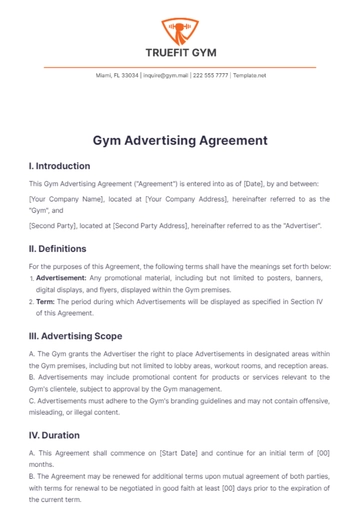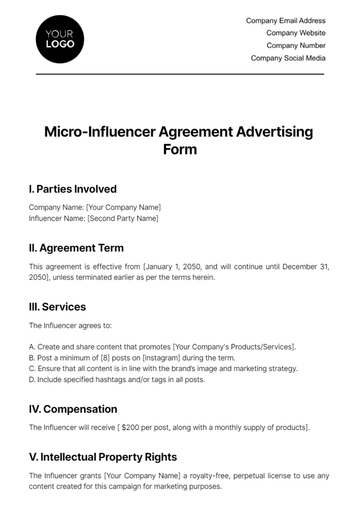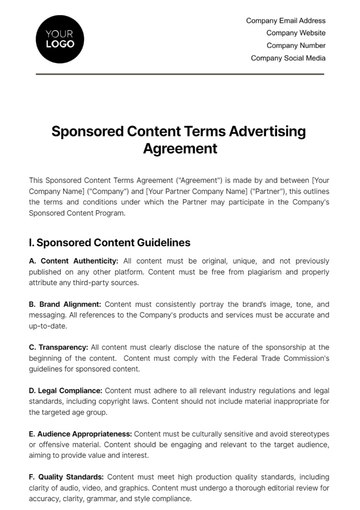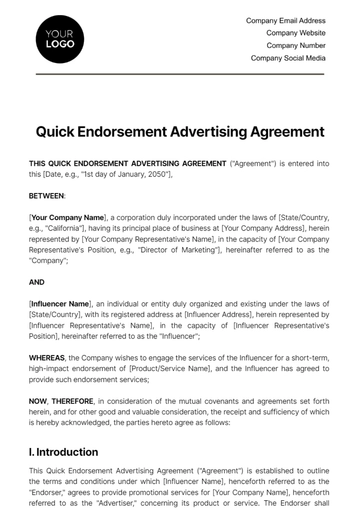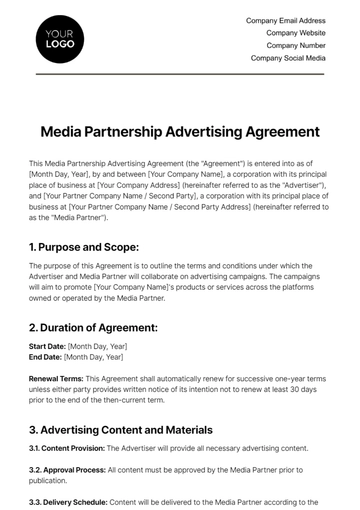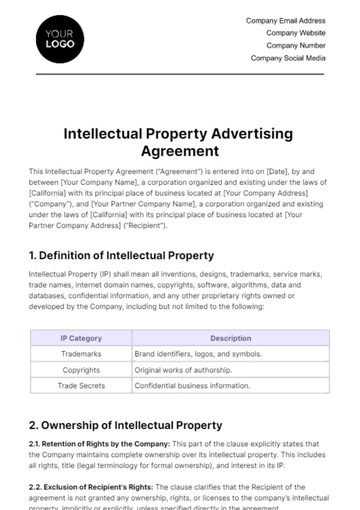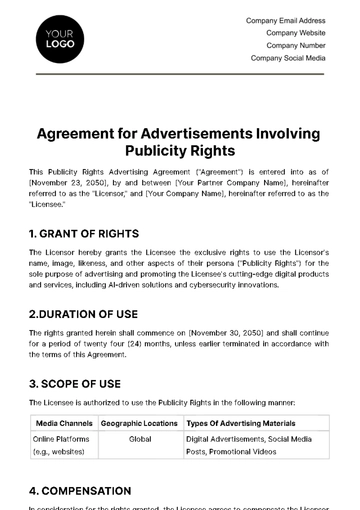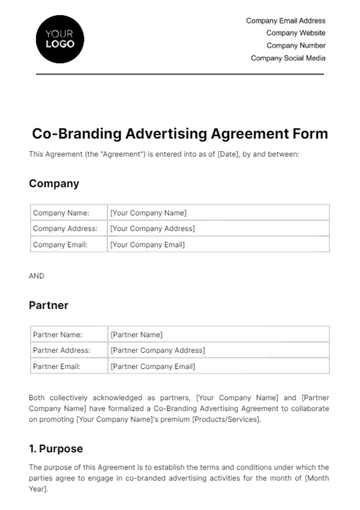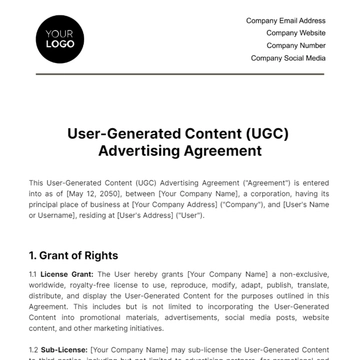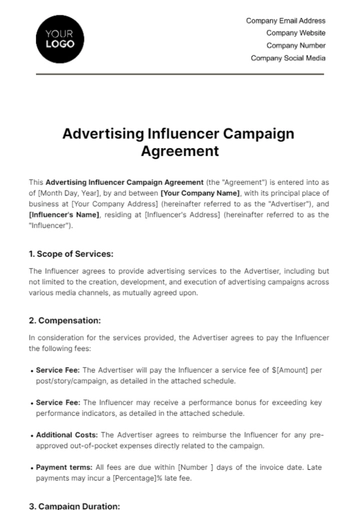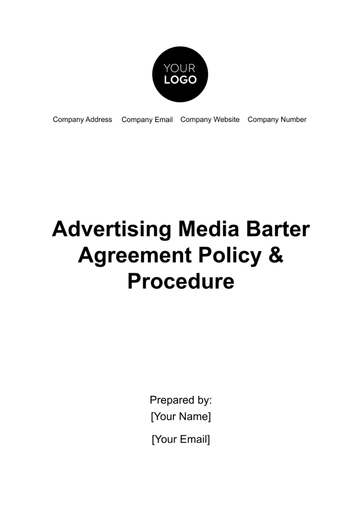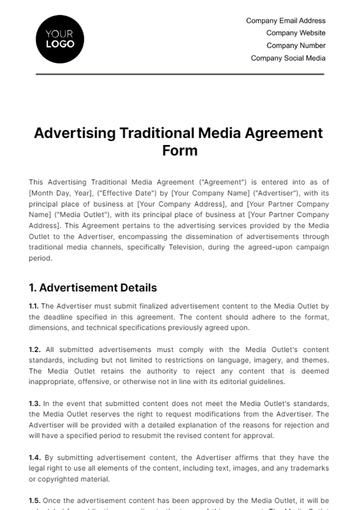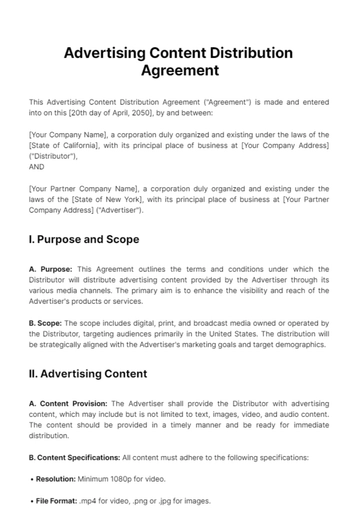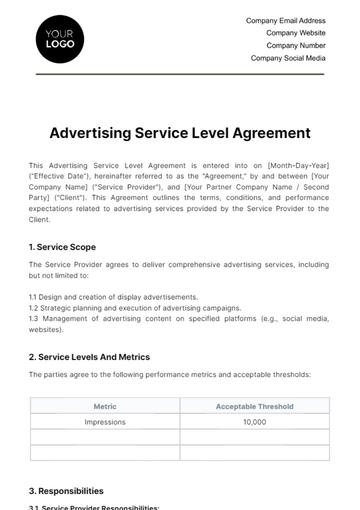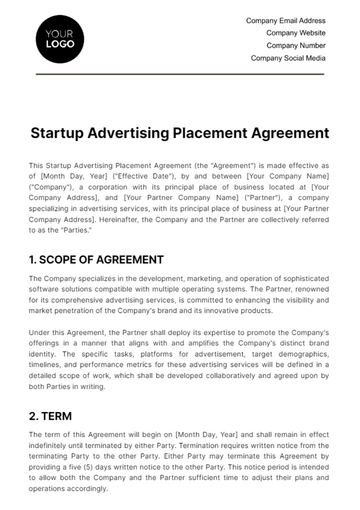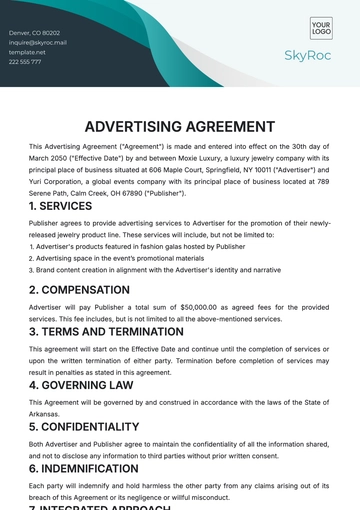Free Advertising Media Barter Agreement Policy & Procedure
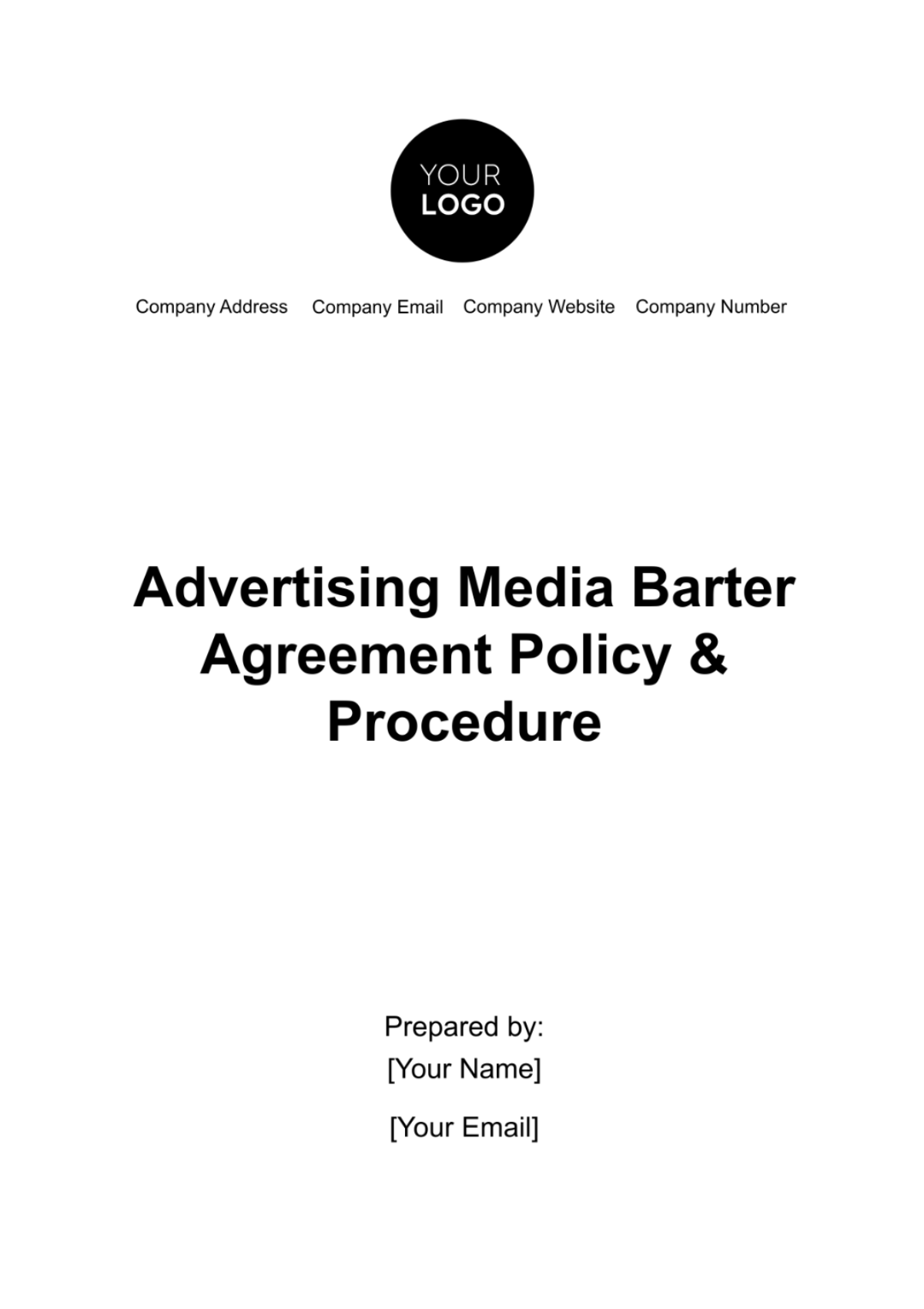
I. Introduction
The purpose of this document is to establish a comprehensive policy and procedural framework for entering into and managing media barter agreements. These agreements allow for the exchange of goods or services for advertising space or time, facilitating a mutually beneficial relationship between our company and our partners. By leveraging assets in lieu of traditional payment, both parties can achieve significant cost savings, access new marketing opportunities, and optimize resource utilization. This document outlines the principles, procedures, and guidelines governing such transactions, ensuring clarity, fairness, and strategic alignment with our company's objectives.
II. Scope
This policy and procedure document applies to all departments and units within our organization that may engage in or support the execution of media barter agreements. It covers the exchange of goods and services for advertising space or time across all media channels managed by our company, including but not limited to digital, broadcast, and print media. The document delineates the boundaries of acceptable barter transactions, explicitly excluding any exchanges that do not comply with applicable laws, regulations, or our company’s ethical standards. It is designed to ensure that all barter agreements align with our strategic marketing goals and financial policies.
III. Definitions
To ensure clarity and a common understanding, several key terms used throughout this document are defined as follows:
Barter Agreement: A contract between two parties in which goods or services are exchanged for advertising space or time, without the exchange of monetary payment.
Media Value: The monetary worth of advertising space or time, as determined by standard market rates and our company's internal valuation methods.
Goods and Services: Tangible products and intangible services offered by a barter partner in exchange for advertising space or time.
Advertising Space or Time: Slots available for advertising in various media channels managed by our company, including digital platforms, broadcast media, and print publications.
Barter Partner: An entity that enters into a barter agreement with our company, offering goods or services in exchange for advertising space or time.
Compliance: Adherence to applicable laws, regulations, and company policies governing barter transactions and advertising practices.
Valuation Methodology: The process and criteria used to determine the value of goods, services, and advertising space or time involved in a barter agreement.
IV. Policy Statement
Our company is committed to engaging in media barter agreements that are mutually beneficial, ethically sound, and strategically aligned with our marketing and financial goals. These agreements allow us to leverage our advertising assets creatively and efficiently, fostering partnerships that can lead to innovative marketing solutions and enhanced brand visibility. In pursuing these agreements, we adhere to a set of guiding principles to ensure transparency, fairness, and value for both parties involved.
Mutual Benefit: All barter agreements must provide clear and tangible benefits to both parties.
Transparency: The terms of each agreement, including the valuation of goods, services, and media space or time, must be clearly defined and agreed upon by all parties.
Compliance: Agreements must comply with all relevant laws, regulations, and industry standards, as well as our internal policies.
Strategic Alignment: Barter agreements should support our strategic marketing objectives and not detract from our brand values or reputation.
Fair Valuation: Goods, services, and advertising space or time must be fairly valued using established methodologies to ensure equity in the exchange.
V. Roles and Responsibilities
The successful execution of media barter agreements involves the collaboration of several key roles within our organization. The following table outlines these roles and their associated responsibilities in the barter agreement process.
Role | Responsibilities |
Advertising Sales Team | Identify potential barter opportunities; negotiate terms; manage partner relations. |
Legal Department | Draft, review, and approve barter agreements; ensure legal compliance. |
Finance Department | Valuate goods, services, and media space or time; oversee financial reporting and compliance. |
Marketing Department | Assess strategic alignment of barter agreements with marketing objectives; approve marketing content. |
Operations Team | Facilitate the execution and fulfillment of agreed-upon goods and services. |
Compliance Officer | Monitor adherence to laws and regulations; conduct periodic audits of barter agreements. |
VI. Procedure for Initiating Barter Agreements
A. Steps for Proposing a Barter Agreement
The initiation of a media barter agreement follows a structured process to ensure that each potential partnership is evaluated thoroughly and aligns with our strategic objectives. This process promotes efficient and effective negotiation and execution of agreements.
Identification of Potential Partners: The Advertising Sales Team identifies potential barter partners with goods or services that match our strategic needs.
Preliminary Discussion: Initial contact is made with the potential partner to discuss the possibility of a barter agreement.
Internal Evaluation: A preliminary internal evaluation is conducted to assess the potential value and strategic fit of the proposed barter.
Proposal Development: A detailed proposal is developed, outlining the terms of the barter, including the goods or services and advertising space or time to be exchanged.
Review and Approval: The proposal is reviewed by the Legal, Finance, and Marketing Departments for approval.
Negotiation: Negotiations are conducted with the potential partner to finalize the terms of the agreement.
Formal Agreement Drafting: Once terms are agreed upon, the Legal Department drafts the formal barter agreement.
Final Approval and Execution: The final agreement is reviewed and signed by authorized representatives from both parties.
B. Evaluation Criteria
Before entering into a barter agreement, potential partnerships and offers are evaluated based on specific criteria to ensure they meet our strategic, financial, and operational objectives.
Criteria | Description |
Strategic Alignment | The extent to which the proposed barter supports our strategic marketing objectives. |
Value Equivalence | The fairness of the value exchange between the offered goods/services and the media space/time. |
Partner Reliability | The potential partner’s reputation, reliability, and ability to fulfill the terms of the agreement. |
Legal and Regulatory Compliance | Ensuring the agreement complies with all relevant laws and regulations. |
Impact on Brand | The potential impact of the partnership on our brand image and market positioning. |
C. Required Documentation and Approvals
To formalize a barter agreement, several documents must be prepared and approvals obtained, ensuring that each transaction is well-documented and sanctioned by the appropriate authorities within our organization.
Barter Proposal: A document detailing the proposed exchange, including descriptions of the goods or services and advertising space or time.
Value Assessment Report: An evaluation of the fair market value of the goods/services and media space/time involved in the agreement.
Partner Evaluation Form: A review of the potential partner's suitability, reliability, and strategic fit.
Draft Barter Agreement: The initial draft of the barter agreement, outlining the terms of the exchange, responsibilities of each party, and any other relevant conditions.
Approval Forms: Signed approval forms from the Legal, Finance, and Marketing Departments, confirming their review and consent to proceed with the agreement.
VII. Valuation of Goods and Services
The valuation of goods and services offered in a media barter agreement is a critical step to ensure fairness and transparency in the exchange. Our methodology for valuation is based on market rates, quality, demand, and relevance to our strategic needs. For media space or time, we consider standard advertising rates, audience metrics, and the specific value that the placement offers to the advertiser. The goal is to achieve equivalence in value, ensuring that the exchange is equitable for both parties. This process involves thorough research and consultation with experts within relevant fields to ascertain accurate valuations. Documentation supporting the valuation, including market comparisons and internal assessments, must be compiled to justify the agreed-upon values.
VIII. Agreement Drafting and Review
Drafting and reviewing the barter agreement is a meticulous process that ensures all terms are clearly defined and mutually beneficial. This phase is essential for protecting the interests of both parties and ensuring compliance with applicable laws and regulations.
Draft Preparation: The Legal Department prepares the initial draft of the barter agreement, incorporating the terms negotiated.
Internal Review: The draft is reviewed internally by the Advertising Sales, Finance, and Marketing Departments to ensure alignment with strategic goals and fair valuation.
External Review: The draft agreement is shared with the barter partner for review, feedback, and suggestions.
Negotiation of Terms: Any discrepancies or requests for changes by the barter partner are negotiated until a mutual agreement is reached.
Legal Finalization: The Legal Department incorporates final amendments and conducts a comprehensive legal review.
Approval for Execution: The final draft is submitted for approval by the designated authorities within both organizations.
IX. Execution and Fulfillment
A. Steps for Executing the Agreement
The execution of a barter agreement marks the formal commencement of the partnership and obligates both parties to fulfill their respective terms.
Signing Ceremony: Organize a formal signing ceremony or meeting, if necessary, to sign the agreement.
Exchange of Documents: Exchange signed copies of the agreement and any other relevant documentation.
Implementation Kick-off: Coordinate with relevant departments to initiate the implementation of the agreement’s terms.
Public Announcement: If agreed upon, prepare and release a public announcement of the partnership.
B. Monitoring the Fulfillment of Terms by Both Parties
Continuous monitoring of the agreement's fulfillment is crucial to ensure that both parties adhere to their commitments.
Establish Milestones: Define clear milestones for the delivery of goods/services and the utilization of media space/time.
Regular Updates: Schedule regular update meetings or calls to discuss progress and any issues.
Performance Reports: Require periodic performance reports from both parties, detailing the fulfillment of their obligations.
Feedback Mechanism: Implement a feedback mechanism to address any concerns or suggestions for improving the partnership.
C. Handling Discrepancies or Failures to Deliver
In the event of discrepancies or failures to deliver on the agreed terms, a structured approach is essential to resolve issues amicably and efficiently. A procedure for addressing such situations should include:
Immediate Notification: The party observing the discrepancy or failure should notify the other party immediately, detailing the issue.
Assessment: Both parties assess the situation to understand the causes and potential impacts.
Negotiation: Engage in discussions to find a mutually acceptable solution, whether it involves compensation, extension of terms, or other corrective actions.
Amendment: If necessary, formally amend the agreement to reflect any changes agreed upon.
Legal Resolution: As a last resort, seek legal resolution in accordance with the dispute resolution terms outlined in the agreement.
X. Reporting and Record-Keeping
Effective reporting and meticulous record-keeping are fundamental to the integrity and transparency of barter agreements. These practices not only facilitate financial reporting and compliance but also provide valuable insights for future negotiations and partnerships. We mandate comprehensive documentation of all the following documentation:
Barter Agreement Copies
Valuation Documentation
Execution Records
Performance Reports
Financial Records
Audit Trails
XI. Compliance and Auditing
Adhering to the following legal standards and conducting regular audits are critical to ensuring that our barter agreements comply with all applicable laws and regulations. This vigilance protects both parties and maintains the integrity of our business practices.
Internal Revenue Code (IRC)
Uniform Commercial Code (UCC)
Federal Trade Commission (FTC) Guidelines
Sarbanes-Oxley Act
XII. Amendment and Termination
Barter agreements, like any business contract, may need to be amended or terminated due to changing circumstances. It is essential to have clear conditions and processes in place for both amendment and orderly termination to manage these changes effectively and maintain positive relationships between parties.
A. Conditions
Mutual Consent
Breach of Agreement
Legal or Regulatory Changes
Operational Challenges
Bankruptcy or Closure
B. Process for Orderly Termination
Notification: Provide written notice to the other party, specifying the reason for termination and the effective date.
Settlement of Obligations: Agree on the settlement of any outstanding obligations under the agreement.
Documentation: Document the termination process, including final performance reports and the settlement of obligations.
Return of Assets: Arrange for the return of any assets or materials exchanged as part of the agreement, if applicable.
Official Termination: Sign an official termination agreement, legally concluding the barter arrangement.
XIII. Dispute Resolution
In the event of disputes arising from the barter agreement, it is essential to have a clear and effective process for resolution. Our approach prioritizes amicable solutions, aiming to preserve the relationship between the parties while ensuring fairness and adherence to the agreement's terms. The process should begin with direct negotiation between the involved parties, attempting to reach a mutual understanding and remedy any issues informally. If the dispute cannot be resolved through negotiation, mediation by a third-party mediator may be sought as a non-binding way to facilitate a resolution. As a last resort, arbitration or legal action, as specified within the agreement, may be employed. Throughout this process, maintaining detailed documentation of the dispute and attempts at resolution is crucial for protecting each party's interests and rights.
XIV. Review and Policy Update
The dynamic nature of media, advertising, and legal landscapes necessitates regular reviews and updates of our Advertising Media Barter Agreement Policy & Procedure. These reviews should be scheduled annually or more frequently if significant changes in the business environment, regulatory standards, or our strategic objectives occur. The review process should involve stakeholders from the Legal, Finance, Marketing, and Sales departments to ensure that the policy remains comprehensive, relevant, and aligned with industry best practices and legal requirements. Circumstances that might trigger an immediate policy review include new regulatory requirements, significant shifts in the media market, technological advancements affecting advertising practices, or feedback indicating inefficiencies or oversights in the current policy. Updates should be documented, communicated across the organization, and integrated into training materials to ensure consistent understanding and application of the policy.
- 100% Customizable, free editor
- Access 1 Million+ Templates, photo’s & graphics
- Download or share as a template
- Click and replace photos, graphics, text, backgrounds
- Resize, crop, AI write & more
- Access advanced editor
Secure successful exchanges with the Advertising Media Barter Agreement Policy & Procedure Template from Template.net. This template is fully editable and customizable, offering a clear guide for establishing equitable media barter agreements. Fine-tune policies and procedures in our AI Editor tool, facilitating fair and transparent barter transactions that benefit all parties involved.
You may also like
- Lease Agreement
- Non Compete Agreement
- Rental Agreement
- Prenuptial Agreement
- Non Disclosure Agreement
- Operating Agreement
- Hold Harmless Agreement
- LLC Operating Agreement
- Arbitration Agreement
- Purchase Agreement
- Residential Lease Agreement
- Executive Agreement
- Confidentiality Agreement
- Contractor Agreement
- Partnership Agreement
- Postnuptial Agreement
- Collective Bargaining Agreement
- Loan Agreement
- Roommate Agreement
- Commercial Lease Agreement
- Separation Agreement
- Cohabitation Agreement
- Room Rental Agreement
- Child Custody Agreement
- Employee Agreement
- License Agreements
- Settlement Agreement
- Joint Venture Agreement
- Indemnity Agreement
- Subordination Agreement
- Sales Agreement
- Agreements Between Two Parties
- Business Agreement
- Real Estate Agreement
- HR Agreement
- Service Agreement
- Property Agreement
- Agreement Letter
- Restaurant Agreement
- Construction Agreement
- Finance Agreement
- Marketing Agreement
- Payment Agreement
- Investment Agreement
- Management Agreement
- Nonprofit Agreement
- Software Agreement
- Startup Agreement
- Agency Agreement
- Copyright Agreement
- Collaboration Agreement
- Reseller Agreement
- Car Rental Agreement
- Cleaning Services Agreement
- Consultant Agreement
- Deed Agreement
- Car Agreement
- Equipment Agreement
- Shares Agreement
- Data Sharing Agreement
- Advertising Agreement
- School Agreement
- Franchise Agreement
- Event Agreement
- Travel Agency Agreement
- Vehicle Agreement
- Board Resolution Agreement
- Land Agreement
- Binding Agreement
- Tenancy Agreement
- Exclusive Agreement
- Development Agreement
- Assignment Agreement
- Design Agreement
- Equity Agreement
- Mortgage Agreement
- Purchase and Sale Agreement
- Shareholder Agreement
- Vendor Agreement
- Royalty Agreement
- Vehicle Lease Agreement
- Hotel Agreement
- Tenant Agreement
- Artist Agreement
- Commission Agreement
- Consignment Agreement
- Debt Agreement
- Recruitment Agreement
- Training Agreement
- Transfer Agreement
- Apprenticeship Agreement
- IT and Software Agreement
- Referral Agreement
- Resolution Agreement
- Waiver Agreement
- Consent Agreement
- Partner Agreement
- Social Media Agreement
- Customer Agreement
- Credit Agreement
- Supply Agreement
- Agent Agreement
- Brand Agreement
- Law Firm Agreement
- Maintenance Agreement
- Mutual Agreement
- Retail Agreement
- Deposit Agreement
- Land Purchase Agreement
- Nursing Home Agreement
- Supplier Agreement
- Buy Sell Agreement
- Child Support Agreement
- Landlord Agreement
- Payment Plan Agreement
- Release Agreement
- Research Agreement
- Sponsorship Agreement
- Buyout Agreement
- Equipment Rental Agreement
- Farm Agreement
- Manufacturing Agreement
- Strategic Agreement
- Termination of Lease Agreement
- Compliance Agreement
- Family Agreement
- Interior Design Agreement
- Ownership Agreement
- Residential Lease Agreement
- Retainer Agreement
- Trade Agreement
- University Agreement
- Broker Agreement
- Dissolution Agreement
- Funding Agreement
- Hosting Agreement
- Investor Agreement
- Memorandum of Agreement
- Advisory Agreement
- Affiliate Agreement
- Freelancer Agreement
- Grant Agreement
- Master Service Agreement
- Parking Agreement
- Subscription Agreement
- Trust Agreement
- Cancellation Agreement
- Horse Agreement
- Influencer Agreement
- Membership Agreement
- Vacation Rental Agreement
- Wholesale Agreement
- Author Agreement
- Distributor Agreement
- Exchange Agreement
- Food Agreement
- Guarantee Agreement
- Installment Agreement
- Internship Agreement
- Music Agreement
- Severance Agreement
- Software Development Agreement
- Storage Agreement
- Facility Agreement
- Intercompany Agreement
- Lending Agreement
- Lodger Agreement
- Outsourcing Services Agreement
- Usage Agreement
- Assurance Agreement
- Photography Agreement
- Profit Sharing Agreement
- Relationship Agreement
- Rent To Own Agreement
- Repayment Agreement
- Volunteer Agreement
- Co Parenting Agreement
- HVAC Agreement
- Lawn Care Agreement
- SAAS Agreement
- Work from Home Agreement
- Coaching Agreement
- Protection Agreement
- Security Agreement
- Repair Agreement
- Agreements License
